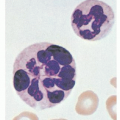Thrombocytopenia: Pathophysiology and Classification
George M. Rodgers
PATHOPHYSIOLOGY
Thrombocytopenia may be defined as a subnormal number of platelets in the circulating blood. It is the most common cause of abnormal bleeding. Despite the number and diversity of disorders that may be associated etiologically, thrombocytopenia results from only four processes: artifactual thrombocytopenia, deficient platelet production, accelerated platelet destruction, and abnormal distribution or pooling of the platelets within the body (Fig. 46.1). The changes in the basic parameters of thrombopoiesis that are characteristic of each of these processes are summarized in Table 46.1.
Artifactual Thrombocytopenia
Artifactual thrombocytopenia, or falsely low platelet counts, occurs ex vivo when platelets are not counted accurately. This mechanism should be considered in patients who have thrombocytopenia but no petechiae or ecchymoses. Although inaccurate counting may occur in the presence of giant platelets1 or with platelet satellitism,2 the most common cause of artifactual thrombocytopenia is platelet clumping (pseudothrombocytopenia).3 Platelet clumping in pseudothrombocytopenia appears to be caused by anticoagulant-dependent platelet agglutinins that are immunoglobulins (Igs) of IgG, IgA, or IgM subtypes. Although clumping is most commonly seen when blood is collected into ethylenediaminetetraacetic acid anticoagulant, other anticoagulants may cause clumping, even hirudin or Phe-Pro-Arg chloromethyl ketone.4 Platelet clumping is also timedependent and varies with the type of instrumentation used for automatic counting.4 There is evidence that the autoantibodies bind to glycoprotein IIb/IIIa,5 and in one study, there was over 80% concordance between the presence of anticardiolipin antibody and platelet agglutinins in individual patient plasmas.6 These autoantibodies have no known associations with disease or drugs and have been noted in some patients for over 10 years.7
Accelerated Platelet Destruction
Accelerated platelet destruction is the most common cause of thrombocytopenia. It leads to stimulation of thrombopoiesis and, consequently, to an increase in the number, size, and rate of maturation of the precursor megakaryocytes (Fig. 46.1).8 When the rate of platelet destruction exceeds this compensatory increase in platelet production, thrombocytopenia develops. “Compensated” platelet destruction without thrombocytopenia also may occur in patients with prosthetic heart valves and in patients with idiopathic thrombocytopenic purpura after splenectomy.9, 10, 11
Platelet destruction may result from both intracorpuscular defects and extracorpuscular abnormalities. Intracorpuscular defects are rare but have been demonstrated in certain forms of hereditary thrombocytopenia, such as Wiskott-Aldrich syndrome (see Chapter 49).12 In such disorders, the survival of affected platelets is shortened in the circulation of both the patient and normal recipients. Platelets injured by either intracorpuscular or extracorpuscular processes usually are removed from the circulation by the spleen, liver, and reticuloendothelial system. Platelet destruction most often is the result of extracorpuscular factors; various immunologic phenomena are the most common. Immunologic platelet destruction is discussed in Chapter 47.
Platelet consumption in intravascular thrombi or on damaged endothelial surfaces is another cause of thrombocytopenia. This occurs in disseminated intra vascular coagulation (see Chapter 54) and in thrombotic thrombocytopenic purpura (see Chapter 48) and other microangiopathic processes. Thrombocytopenia caused by other nonimmunologic platelet destruction is discussed in Chapter 49.
Stay updated, free articles. Join our Telegram channel

Full access? Get Clinical Tree







